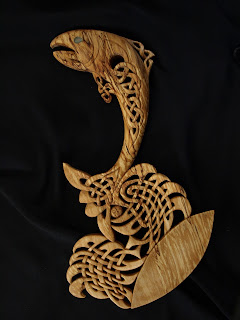handle to form half of an upside down heart shape, the tapering knotwork blends its complicated twists and turns beautifully with the fair curves of the handle and the reverse turn on the crown caps things off really nicely.It looks pretty easy, but believe me, it took a long time on paper before those simple lines looked 'just right'. A fraction of an inch either way and things became too fat or too thin, too long or too short....now I know why Goldilocks was such a fussy little so-and-so!!
 Separate from the artistic exploration, I couldn't lose sight of the spoon's purpose...it is, first and formost, a lovespoon. I wanted a simple heart to send an unambiguous message of love but in a way that didn't render the design 'kitschy' or make the spoon a bit hokey. I chose to centre the heart at the middle of the top curve and to keep it very clean and straightforward. It commands the eye, but it doesn't detract from the rest of the design. I'm happy.
Separate from the artistic exploration, I couldn't lose sight of the spoon's purpose...it is, first and formost, a lovespoon. I wanted a simple heart to send an unambiguous message of love but in a way that didn't render the design 'kitschy' or make the spoon a bit hokey. I chose to centre the heart at the middle of the top curve and to keep it very clean and straightforward. It commands the eye, but it doesn't detract from the rest of the design. I'm happy.But here is my favourite part of the whole design! It's probably not the most dramatic or 'in your face' part of the spoon, but I love how everything converges in this one little spot just above the bowl. The lines are all clean but are very dramatic, they create tension but also resolve in a comfortable manner. OK, maybe not everyone's cup of tea, but I find derive great pleasure from making these simple lines work out! Even the somewhat brittle birch wood cooperated and let me off without any chipping or tear-out!
Most spooncarvers, and I am no exception, design their spoons to be hung vertically on the wall. I have found it is always a good idea to look at the spoon from several angles though. Sometimes, the spoon doesn't look 'quite right' on the wall and it isn't until it is viewed horizontally or from the top down that imbalances appear which hamper the success of the design. For me, this spoon works equally well hung vertically or horizontally and lets me know that I've managed to balance everything as well as I can.
This might look a simple little spoon, but there's more going on than first meets the eye!!




